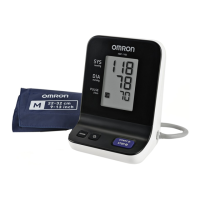24
Check before Use
Before turning on the power
Before turning on the power, check for the following
Ŷ External appearance
• The monitor or accessories are not deformed due to falling or other
impact.
• The monitor is not dirty.
• The monitor is not wet.
Ŷ AC adapter
• The AC adapter is ¿ rmly connected to the connector on the monitor.
• There are no heavy objects lying on the AC adapter cable.
• The AC adapter cable is not damaged (core-wire exposure, breaks, etc.).
When turning on the power
When you turn on the power, check the
LCD display.
• When the [START/STOP] or [Power
ON/OFF] button is pressed to turn on
the power, the right screen appears.
After turning on the power
After turning on the power, check for the following
Ŷ External appearance
• There is no smoke or odor coming from the monitor.
• The monitor is not making any unusual noises.
Ŷ Buttons
• Press each button and check that it works.
Ŷ Non-invasive blood pressure (NIBP)
• Make sure that a suitable OMRON GS CUFF is attached (one that ¿ ts
the circumference of the patient's arm).
• The cuff tube is ¿ rmly connected.
• The person checking the cuff should wrap the cuff around arm, perform
cuff measurement and check to see that blood pressure is in the
vicinity of normal measurements.
• While measurement is in progress, bend the relevant arm and move
body to halt discharge and during this halt check that cuff pressure
does not drop.

